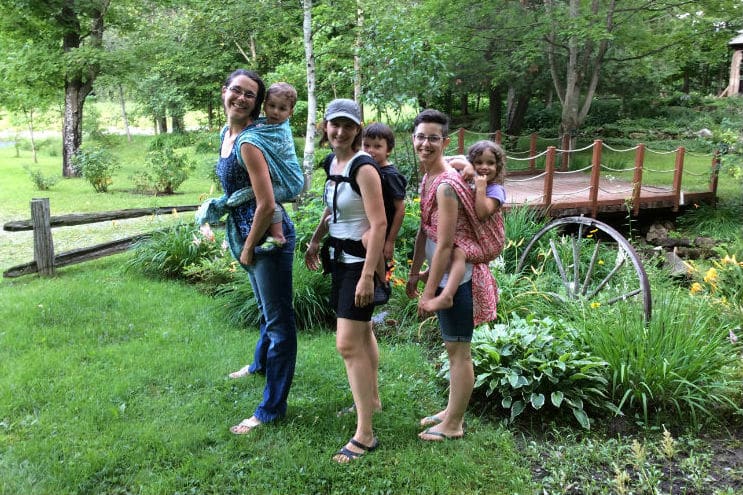To learn more about babywearing, read The History of Babywearing.
In this part of the article, you will learn about the benefits of babywearing, both for babies and parents.
The benefits for the baby are many:
- Reassuring, close contact after childbirth
- The baby’s body will warm up faster
- For premature babies, direct contact using the kangaroo method
- Baby cries less
- Helps digestion by maintaining a vertical position (ex.: reflux)
- Helps build attachment
- Comforts the baby
- Helps develop trust in themselves, their parents and their environment
- Promotes cognitive development. All their senses are called upon when participating in their parent’s activities (observation, curiosity, smell, touch, sound, etc.)
- Helps the baby sleep because they are rocked by their parent’s movements
- A moment of pleasure
Benefits for parents:
- Helps develop an attachment with the baby
- The feeling of the baby next to you helps the transition from pregnancy to future independence
- Meet the baby’s needs quickly
- Allows freedom of movement of your arms to take care of daily tasks (practical, useful, reduces stress)
- The baby is not as heavy if adequately supported, which eases transportation (less energy and very ergonomic if properly installed)
- Less postpartum depression in new mothers as babywearing allows mothers to feel more skilled and confident in their roleHelps note signs of hunger when breastfeeding, promotes more prolonged periods of breastfeeding early in life.
Security and Babywearing
Unfortunately, Canada does not have safety standards for baby carrier manufacturers. But they have to refer to voluntary standards set by the American Society for Testing and Materials (ASTM). But not all models are safe for babies.
There are many types of good, safe, practical baby carriers, but you have to use them properly to avoid injury and suffocation. YES! There are risks associated with babywearing, but most of them can be prevented if you are aware of them. Based on medical statistics, babies may be injured because the parent fell, because the product was defective and the baby fell out of the carrier, or the baby was not correctly installed, and their nose was blocked, preventing air circulation.
Babywearing is great, but you have to do it safely:
- Always be able to see your baby’s face and make sure their nose is clear of obstacles to ensure proper breathing and avoid suffocation
- Make sure you support them when making specific movements, such as bending over
- Make sure the baby carrier is in good condition
- Install the baby ergonomically based on the baby carrier model chosen
- Be selective of activities you do when babywearing, because jogging may not be the best idea, or leaning over an open oven door, or when drinking hot liquids that might spill on the baby…
You will see that some babies will get used to babywearing quickly, but some may react differently. If the baby cries or leans backwards when being placed in their carrier, you may want to check for a stiff neck or stiffness elsewhere. Babywearing may be uncomfortable for them. If this is the case, you might want to go to an osteopath. A baby also needs to get used to babywearing, and sometimes it will take a couple of tries. Parents should start slow, and then extend the periods when the baby is used to the position.
To learn about different ways to babywear, read Different Babywearing Options.


